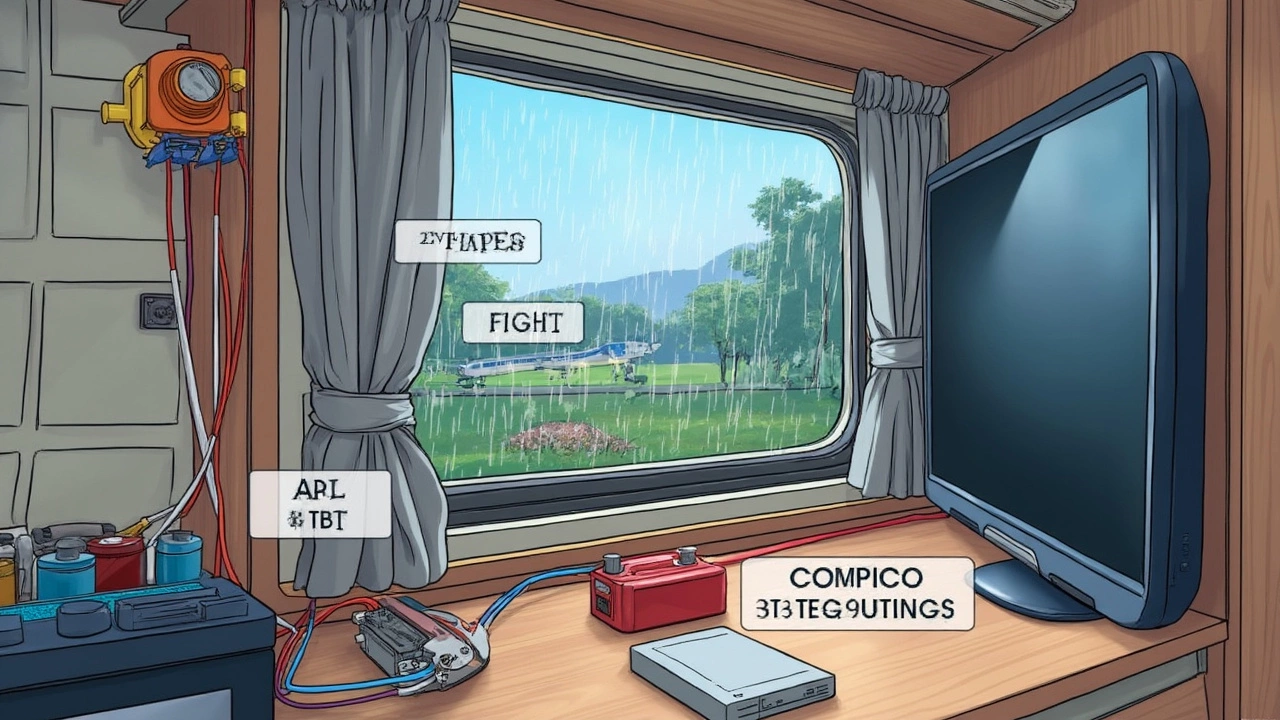Picture this: you're camped under a starlit sky after a long drive in your motorhome, but you don't want to miss the big game or your favorite show. Is it as easy as plugging your 12-volt TV straight into your battery? Pretty much, but there are a few things you need to know if you want your TV—and your battery—to last the whole trip.
Most 12-volt TVs are designed for life on the road, so they run on the same voltage as your typical leisure battery. You can often hook one up using the 12-volt sockets already in most motorhomes or even wire it directly if you know your way around a battery. But, just because you can connect it doesn't mean you should throw caution to the wind. Right setup = happy TV time; bad setup = dead battery and a dark screen. Let’s clear up the basics first, then dive into what really matters: keeping your gear safe without draining your precious power.
- How 12-Volt TVs Work in Motorhomes
- Connecting Directly to a Battery—Is It Safe?
- Battery Drain: What You Need to Know
- Gear That Makes Life Easier
- Smart Habits for Watching TV Off-Grid
How 12-Volt TVs Work in Motorhomes
Here’s the deal—12-volt TVs are built for life on the move. They’re made to plug right into your motorhome’s battery system, which runs on 12 volts DC (direct current). No extra adapters, no hunting for special wall outlets. So if your camper has a standard 12V socket, you’re already halfway there.
Unlike regular home TVs that need mains power (230V AC in Europe, 120V AC in North America), 12-volt models draw power just like your RV lights or water pump. This is what makes them perfect for off-grid use—their low energy demand is easier on your battery, so you get more TV time before you need a recharge. According to a 2024 review by Practical Motorhome, “A 19-inch LED 12V TV typically uses 2-3 amps per hour, while a regular household TV and inverter combo can use twice as much.”
"12-volt televisions are essential in the world of motorhomes because they’re designed to cope with voltage fluctuations and rough roads, giving you reliable entertainment wherever you park." — Practical Motorhome Magazine, March 2024
Let’s make that more concrete. If your leisure battery holds 100Ah (amp-hours) and your TV pulls 2.5A, you can do the math:
| Battery Size (Ah) | TV Draw (A) | Approx. Runtime (hours) |
|---|---|---|
| 100 | 2.5 | 40 |
This is a best-case scenario—realistically, you’ll also be using lights, charging phones, maybe the heater’s fan. Still, it shows why 12-volt TVs are popular with motorhomers.
One more thing: these TVs usually come with robust mounting options so they won’t bounce around, and they’re designed to put up with temperature swings and bumps from travel. If you want straightforward, low-hassle entertainment on the road, the 12-volt TV is built for exactly that.
Connecting Directly to a Battery—Is It Safe?
Wiring a 12-volt TV right to your battery sounds simple—you just match positive to positive and negative to negative, right? Here’s where you need to slow down. While this does work, doing it wrong can fry your TV, cause annoying flickering, or even lead to melted wires. The most important thing is to protect both your 12-volt TV and your battery from trouble.
The big risk comes with power spikes. When you start your engine, batteries can surge to over 14 volts for a while, which is fine for charging but can cause problems for sensitive electronics. That’s why caravan and RV setups usually run these things through a fuse and sometimes a voltage regulator. If your TV expects exactly 12 volts and you feed it more, you could see it shut off, glitch out, or die way too soon.
You’ll also need to watch your wiring. Too-thin wires can heat up if your TV draws a decent current, which is pretty common once you add satellite boxes or sound bars. At best, you get fuzzy reception. At worst, you could melt insulation or trip fuses. Always use the gauge of wire your TV manual calls for, and keep your cable runs as short as possible for less voltage drop.
Here's a basic checklist that keeps things safe:
- Always put a fuse in line with your TV before it reaches the battery—a 3 to 5 amp blade fuse works for most TV sizes.
- If you’re handy, a cheap 12V voltage regulator makes sure your TV always gets clean power, even during charging cycles.
- Use proper ring or spade connectors instead of just twisting wires together.
- If your TV came with a cigarette lighter plug, use outlets already wired for 12V. Don’t cut those off unless you know exactly what you’re doing.
Done right, running your 12-volt TV straight from a battery is safe and easy. Skip the shortcuts, use decent hardware, and you’ll never have to worry about your gear leaving you in the dark.

Battery Drain: What You Need to Know
Worried that running your TV will leave you stranded with a flat battery? You’re not alone. Battery drain is probably the top concern when folks think about using a 12-volt TV in their motorhome. TVs for campers usually pull around 2 to 4 amps per hour. That means a 40-amp hour run if you leave your 3-amp TV on for about 13 hours. Sounds fine for a night or two, but there’s a catch—other gadgets want a piece of that battery too.
Let’s make it visual. Here’s a simple breakdown of how much juice a typical TV draws and what that means for common battery sizes:
| TV Power (Watts) | Current Draw (Amps) | Battery Size (Ah) | Running Time (Hours) |
|---|---|---|---|
| 24W (Small TV) | 2A | 100Ah | 40 |
| 36W (Medium TV) | 3A | 100Ah | 26.6 |
| 48W (Large TV) | 4A | 100Ah | 20 |
Most folks never use the TV non-stop, but it adds up with lights, water pumps, or charging your phone on the same system. Plus, you shouldn’t drain a lead-acid battery below 50%, or you’ll kill its lifespan.
If you know your battery’s amp-hour rating (that’s the big number printed on it), you can do some quick math. Take your TV’s amp draw, add whatever else you’re using, and see how long you can go before hitting the halfway mark. For lithium batteries, you can use up nearly 90% before performance drops, but not so for the old-school types.
Here’s what you can do to slow the drain:
- Pick energy-efficient TVs (look for the lowest watt number).
- Switch off the screen when you’re not watching—even for short breaks.
- Consider running the engine or solar charging during binge sessions if you watch a lot.
- Monitor battery voltage with a cheap gauge to spot any dips early.
If you’re still not sure, try a weekend off-grid test at home. Use the TV the way you would on the road and keep notes on how long your battery lasts. That way, you know exactly what to expect—no nasty surprises on your actual trip.
Gear That Makes Life Easier
If you've ever tried to power your 12-volt TV while boondocking, you know it's not just about plugging in and forgetting it. Having the right gadgets turns a guessing game into a smooth setup. Let me show you what actually helps—and what’s just hype.
- 12-Volt TV: Get a TV that’s truly built for mobile use. These are made for bumps, voltage changes, and low power draw—much easier on your battery than a house TV and they'll outlast budget models.
- Fuse Protection: Always use an inline fuse between the TV and the battery. If a short happens, this little part saves your TV and could even prevent a fire.
- Voltage Regulator: Batteries don’t spit out consistent voltage—especially when charging or running low. A 12V TV can handle small swings, but a $10 voltage regulator keeps things steady. This means fewer random shutdowns or future TV headaches.
- Dedicated 12V Sockets: Most newer motorhomes have built-in 12V outlets. If yours doesn't, wiring one up with thick cable (think 2.5mm2 or bigger) cuts voltage drop and lets your TV run smoother. Don’t use thin, cheap wires—they get hot, waste power, and sometimes melt.
- Low-Voltage Disconnect: This gadget automatically turns your TV off before your battery gets dangerously low. Super handy if you want to avoid killing your leisure battery, especially if you’re running lights, pumps, and phones too.
Here’s a quick look at common gear and what each does in your power setup:
| Gadget | Why Use It? | Average Cost (UK) |
|---|---|---|
| Fuse | Protects wiring & TV | £2-5 |
| Voltage Regulator | Stabilizes voltage for sensitive electronics | £10-25 |
| Low-Voltage Disconnect | Prevents deep discharge of battery | £12-20 |
| Thick Wiring Kit | Reduces voltage drop, stays cool | £10-20 |
| Dedicated 12V Socket | Plug-and-play access for TV | £5-10 |
Don’t skip these add-ons if you’re serious about off-grid TV time. Skimping on small stuff can wreck your trip or your kit. Choose gear made for mobile life—it’ll pay off fast and keep things running for years.

Smart Habits for Watching TV Off-Grid
Ask anyone who’s spent a weekend with a flat battery in the middle of nowhere—it’s no joke. To keep your 12-volt TV running without sucking your battery dry, you need a few simple habits. First off, know when your battery is close to conking out. Most leisure batteries start to drop below critical power at around 12.0 volts, and going much lower can mess them up for good.
One smart move is hooking up a basic voltmeter or battery monitor. They’re cheap and can save you hundreds in ruined batteries. I put one in after a friend’s battery dropped so low their heating wouldn’t start on a frosty morning—never again.
- Limit TV time, especially if you’re running other stuff like lights, fridges, or chargers. Try to save movie nights for when the sun’s out and your solar panel can help refill the battery.
- Turn your TV’s brightness down. Some 24” 12-volt TVs can use as much as 36 watts at full blast, but drop down closer to 20 watts on eco mode. That’s a couple of hours of extra viewing if you’re not plugged in.
- If you’re not actually watching, switch the TV off completely—not just on standby. Standby mode still eats a little power every hour.
- Get in the habit of checking your battery before and after you watch something so you don’t get caught off-guard late at night.
- Charge up or run bigger electronics like satellite boxes only when you have shore power at a campsite, or when the engine’s running.
Here’s a quick table showing how different TVs stack up against your typical leisure battery (assume a 100Ah battery, which is pretty standard for most motorhomes):
| TV Power Use (Watts) | Amps Drawn Per Hour | Estimated Hours Before Battery Hits 50% |
|---|---|---|
| 19W | ~1.6A | About 28-30 hours |
| 36W | ~3.0A | About 16-17 hours |
| 50W (TV + Sat Box) | ~4.2A | About 12 hours |
Notice how quickly you’ll run out if your TV’s a power hog, or you add extra gadgets. And remember, you don’t ever want to run a battery all the way down—aim to use only half its rated capacity between recharges if you want it to last.
If you want a backup plan, you could carry a portable battery booster. I always stash one after my partner, Aveline, and I once had to play cards by torchlight for a whole evening. Never hurts to have a low-tech option, too—a deck of cards, a good book, or old-school radio use next to nothing. That way, you’ll never have to stress about missing out, even when off-grid.






